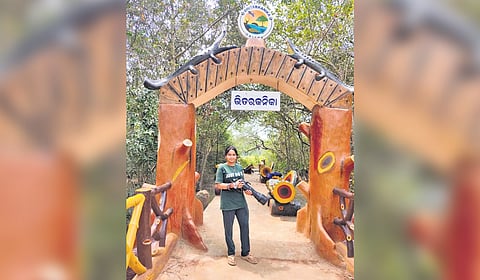

KENDRAPARA: When zoology teacher Subhadarshani Pradhan visited Bhitarkanika national park in 2019, she was enamoured by the beauty of Mangrove pitta ((Pitta megarhyncha), a nearly threatened bird species found in few pockets of eastern India.
After going round the mangrove forests and villages nearby to understand the threats to the bird, the 31-year-old academician began a conservation drive to save the species. Her drive included reaching out to the villagers living in the vicinity of Bhitarkanika to create awareness on the importance of the bird to the local ecology and ways to protect them.
Mangrove pitta is a resident non-migratory bird that generally feeds on crustaceans, mollusks and insects.
“Abundant fish in the river and creeks and distance from human habitation has made Bhitarkanika a suitable congenial breeding place for this bird species,” said Subhadarshani who works as a faculty member at the zoology department of Shree Jagannath College at Rajnagar.
She informed that the bird is a bio-indicator of the health of mangrove forests and its presence indicates that the mangrove ecosystem is healthy and functioning properly, while its absence can indicate disturbances or imbalances in the ecosystem.
She added that denudation of mangrove forests and mushrooming of shrimp farms around Bhitarkanika have been posing a threat to the bird species. Since 2020, she along with forest officials have been organising hundreds of awareness camps in the villages on the safety of the birds.
The breeding season of this bird species ranges from April to August in Bhitarkanika. “Crows, raptors and water monitors eat the bird eggs. Following our awareness drives, villagers are now guarding the trees where the Pitta birds are laying their eggs. They are treating these birds as assets,” she said. Locally, the bird is called ‘Nabarangi’ because of the colours on its body. It has a black head with brown crown, white throat, greenish upper parts, buff under-parts and reddish vent area.
She started the conservation initiative alone but today, she has a small army of her friends and local villagers who are helping her in the job. Subhadarshani added that environmentalists and researchers who come to Bhitarkanika to watch crocodiles are also taking interest in the Mangrove pitta conservation drive.
Last year, the Forest department had sighted 179 Mangrove pitta birds during the first ever census carried out to count the birds in the national park. The census had found a good number of the birds in the core areas of Bhitarkanika.
Bhitarkanika national park’s Assistant Conservator of Forest Manas Das is all praises for Subhadarshini’s efforts towards conserving the bird species. “If more like her join in providing a safe environment for the birds, they will no longer be an endangered species,” he said.
NEARLY ENDANGERED
Habitats of Mangrove pitta birds are confined to mangrove forest areas in Odisha’s Bhitarkanika and Sunderban in West Bengal
It is found in mangrove forests where it feeds on crustaceans, mollusks and insects
Highest number of the birds have been seen in Mahipura river mouth in Bhitarkanika
Their population is under threat due to habitat loss and degradation caused by human activities